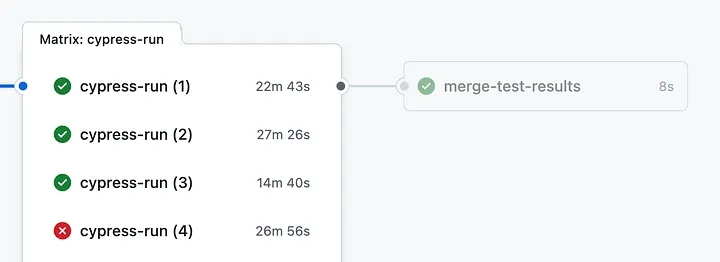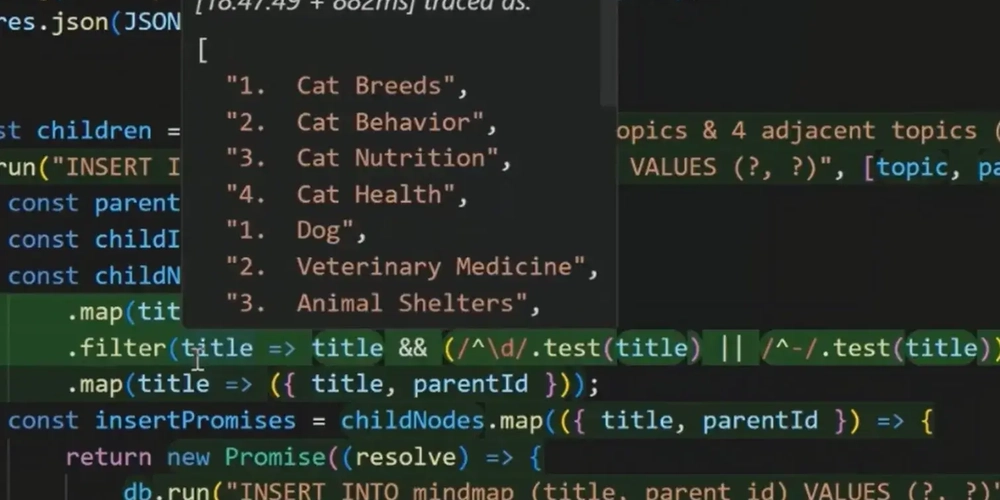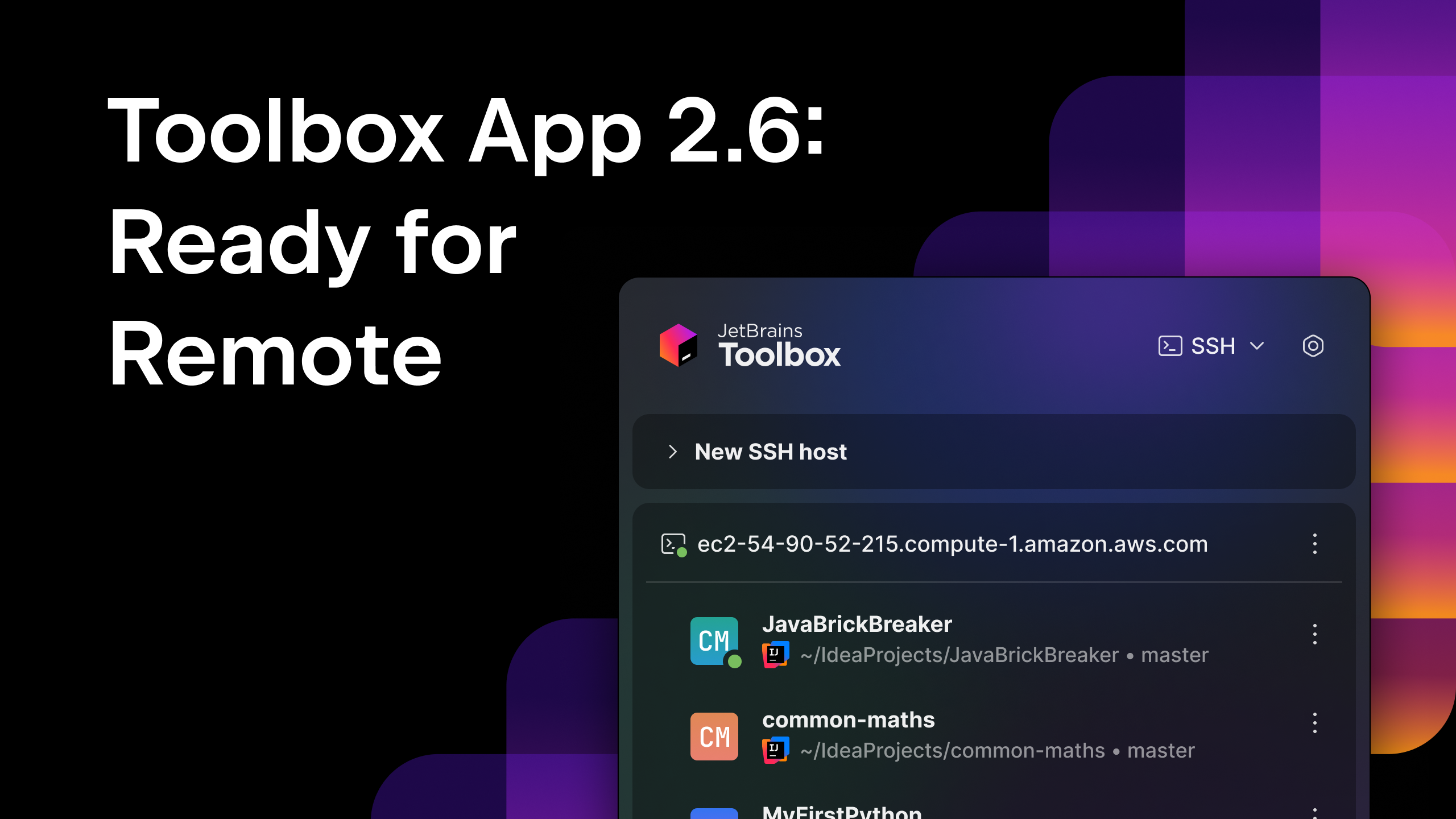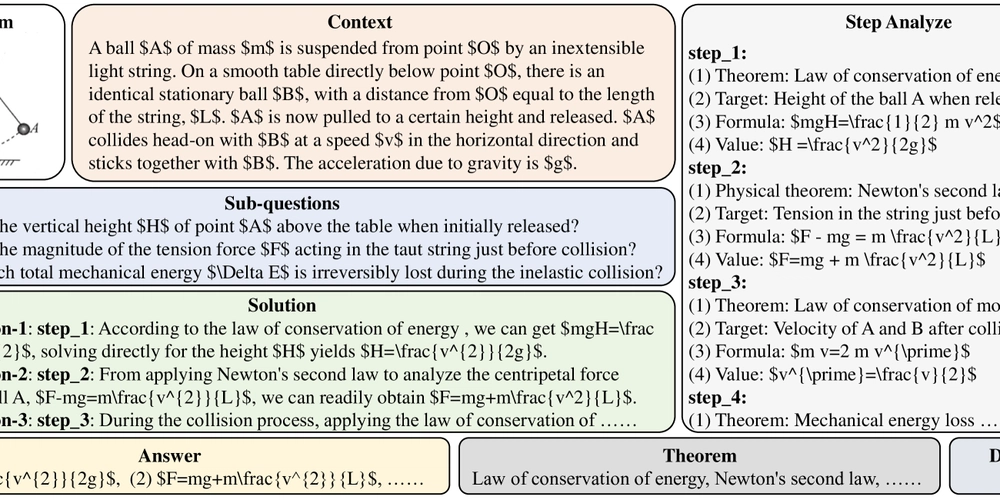Cypress — How to Create a Merge Report in your Pipeline
Cypress Cloud is a powerful tool for tracking test health and identifying long-term patterns. However, for teams without the financial bandwidth to use Cypress Cloud, having access to similar analytics — such as flake percentage, test performance, and failure data — remains essential, especially as test suites grow in size and complexity. Combine that with a test suite running in parallel, and tracking health across multiple runners can quickly become a time-consuming chore. In this blog, I’ll break down an easy pattern you can implement to generate a JSON merge report, providing a single place to track test health and custom analytics. This tutorial assumes your test suite runs in parallel. While it will still work for a single-runner setup, the benefits are magnified when test results are spread across jobs. If you need parallelization, check out the free cypress-split plugin. To create the test report, follow these four steps: Save the test results Merge the test results Add the script to the pipeline Use the report Save the Test Results To begin, we need to save the results of each individual test run. This can be achieved using the after:run event. Here’s an example of how to capture and save results, with each step commented along the way. setupNodeEvents(on, config) { on('after:run', (results) => { // 1. Define results directory const resultsDir = path.join(__dirname, 'cypress/results') // 2. Create the results directory, if it doesn't exist if (!fs.existsSync(resultsDir)) { fs.mkdirSync(resultsDir, { recursive: true }) } // 3. Write the results to a file // Each parallel runner need its own results file. // Use randomUUID to ensure uniqueness const fileName = `test-results-${randomUUID()}.json` // 4. Write the result to the results directory const filePath = path.join(resultsDir, fileName) fs.writeFileSync(filePath, JSON.stringify(results, null, 2)) }) return config } Each parallel runner will now save its own test result file to a shared results folder. Merge the Test Results Next, let’s combine those individual files into a single report. The script below will read all result files, analyze them, and generate a final merged report. Create a new file: merge-results.js const fs = require('fs') const path = require('path') const process = require('process') // 1. Define the results directory and the merged results file path const resultsDir = path.join(__dirname, 'results') const mergedResultsFilePath = path.join(resultsDir, 'merged-results.json') // 2. Create your custom result format JSON // Below is an example of example metrics, you can customize it to suite your needs const overallResults = { totalDuration: 0, totalTests: 0, totalPassed: 0, totalFailed: 0, totalPending: 0, totalSkipped: 0, flakePercentage: 0, } const flakyTests = [] const slowestTests = [] const errors = [] const mergedResults = { ...overallResults, flakyTests, slowestTests, errors, } // 3. Helper methods // Mine convert milliseconds to minutes for better readability const convertMSToSeconds = (ms) => (ms / 1000).toFixed(2) const convertSecondsToMinutes = (ms) => (convertMSToSeconds(ms) / 60).toFixed(2) // Core Method const mergeResults = () => { // 4. Check if the results directory exists, exit if not if (!fs.existsSync(resultsDir)) { console.error('❌ No results directory found.') process.exit(1) } const resultFiles = fs .readdirSync(resultsDir) .filter((file) => file.endsWith('.json') && file !== 'merged-results.json') // 5. Loop through and read each individual result file // Save off the results into a JSON object resultFiles.forEach((file) => { const filePath = path.join(resultsDir, file) const data = JSON.parse(fs.readFileSync(filePath, 'utf8')) // 6. Loop through each test run and extract the relevant metrics data.runs.forEach((run) => { run.tests.forEach((test) => { // Flaky Tests // A test is considered flaky if it has multiple attempts and at least one of them passed if ( test.attempts.length > 1 && test.attempts.some((attempt) => attempt.state === 'passed') ) { flakyTests.push({ test: test.title.join(' - ') }) } // Errors // A test is considered to have failed if its state is 'failed' and it has a displayError if (test.state === 'failed') { const error = test.displayError errors.push({ test: test.title.join(' - '), error, }) } // Slowest Tests // Save off all test regardless of their state slowestTests.push({ test: test.title.join(' - '), duration: convertMSToSeconds(test.duration), }) }) }) // Overall Results mergedResults.totalDuration += data.totalDuration mergedResults.totalTests += data.tota

Cypress Cloud is a powerful tool for tracking test health and identifying long-term patterns. However, for teams without the financial bandwidth to use Cypress Cloud, having access to similar analytics — such as flake percentage, test performance, and failure data — remains essential, especially as test suites grow in size and complexity.
Combine that with a test suite running in parallel, and tracking health across multiple runners can quickly become a time-consuming chore.
In this blog, I’ll break down an easy pattern you can implement to generate a JSON merge report, providing a single place to track test health and custom analytics.
This tutorial assumes your test suite runs in parallel. While it will still work for a single-runner setup, the benefits are magnified when test results are spread across jobs. If you need parallelization, check out the free cypress-split plugin.
To create the test report, follow these four steps:
Save the test results
Merge the test results
Add the script to the pipeline
Use the report
Save the Test Results
To begin, we need to save the results of each individual test run. This can be achieved using the after:run event.
Here’s an example of how to capture and save results, with each step commented along the way.
setupNodeEvents(on, config) {
on('after:run', (results) => {
// 1. Define results directory
const resultsDir = path.join(__dirname, 'cypress/results')
// 2. Create the results directory, if it doesn't exist
if (!fs.existsSync(resultsDir)) {
fs.mkdirSync(resultsDir, { recursive: true })
}
// 3. Write the results to a file
// Each parallel runner need its own results file.
// Use randomUUID to ensure uniqueness
const fileName = `test-results-${randomUUID()}.json`
// 4. Write the result to the results directory
const filePath = path.join(resultsDir, fileName)
fs.writeFileSync(filePath, JSON.stringify(results, null, 2))
})
return config
}
Each parallel runner will now save its own test result file to a shared results folder.
Merge the Test Results
Next, let’s combine those individual files into a single report. The script below will read all result files, analyze them, and generate a final merged report.
Create a new file: merge-results.js
const fs = require('fs')
const path = require('path')
const process = require('process')
// 1. Define the results directory and the merged results file path
const resultsDir = path.join(__dirname, 'results')
const mergedResultsFilePath = path.join(resultsDir, 'merged-results.json')
// 2. Create your custom result format JSON
// Below is an example of example metrics, you can customize it to suite your needs
const overallResults = {
totalDuration: 0,
totalTests: 0,
totalPassed: 0,
totalFailed: 0,
totalPending: 0,
totalSkipped: 0,
flakePercentage: 0,
}
const flakyTests = []
const slowestTests = []
const errors = []
const mergedResults = {
...overallResults,
flakyTests,
slowestTests,
errors,
}
// 3. Helper methods
// Mine convert milliseconds to minutes for better readability
const convertMSToSeconds = (ms) => (ms / 1000).toFixed(2)
const convertSecondsToMinutes = (ms) => (convertMSToSeconds(ms) / 60).toFixed(2)
// Core Method
const mergeResults = () => {
// 4. Check if the results directory exists, exit if not
if (!fs.existsSync(resultsDir)) {
console.error('❌ No results directory found.')
process.exit(1)
}
const resultFiles = fs
.readdirSync(resultsDir)
.filter((file) => file.endsWith('.json') && file !== 'merged-results.json')
// 5. Loop through and read each individual result file
// Save off the results into a JSON object
resultFiles.forEach((file) => {
const filePath = path.join(resultsDir, file)
const data = JSON.parse(fs.readFileSync(filePath, 'utf8'))
// 6. Loop through each test run and extract the relevant metrics
data.runs.forEach((run) => {
run.tests.forEach((test) => {
// Flaky Tests
// A test is considered flaky if it has multiple attempts and at least one of them passed
if (
test.attempts.length > 1 &&
test.attempts.some((attempt) => attempt.state === 'passed')
) {
flakyTests.push({ test: test.title.join(' - ') })
}
// Errors
// A test is considered to have failed if its state is 'failed' and it has a displayError
if (test.state === 'failed') {
const error = test.displayError
errors.push({
test: test.title.join(' - '),
error,
})
}
// Slowest Tests
// Save off all test regardless of their state
slowestTests.push({
test: test.title.join(' - '),
duration: convertMSToSeconds(test.duration),
})
})
})
// Overall Results
mergedResults.totalDuration += data.totalDuration
mergedResults.totalTests += data.totalTests
mergedResults.totalPassed += data.totalPassed
mergedResults.totalFailed += data.totalFailed
mergedResults.totalPending += data.totalPending
mergedResults.totalSkipped += data.totalSkipped
})
// 7. Now that all files have been processed, we can calculate overall metrics
// Convert total duration into a readable format
mergedResults.totalDuration = `${convertSecondsToMinutes(mergedResults.totalDuration)} min`
// Sort the slowest tests by duration
slowestTests.sort((a, b) => b.duration - a.duration)
// Create a overall flake percentage for the run
mergedResults.flakePercentage = (
(flakyTests.length / mergedResults.totalTests) *
100
).toFixed(2)
// 8. Save the merged results to a file
fs.writeFileSync(mergedResultsFilePath, JSON.stringify(mergedResults, null, 2))
console.log(`✅ Merged test results saved at ${mergedResultsFilePath}`)
}
// 9. Call the mergeResults function to execute the script
mergeResults()
Add the Script to the Pipeline
Now that the merge-results.js script is created, let’s utilize it in the CI/CD pipeline. Add a new merge job and ensure it runs after all Cypress run jobs have completed. Below is an example using GitHub Actions.
# Run Cypress Test Job
cypress-run:
runs-on: your-runner # Your runner
strategy:
fail-fast: false
matrix:
containers: [1, 2, 3, 4] # Number of parallel jobs, uses cypress-split
steps:
- name: Checkout
uses: actions/checkout@v4
# 1. Run Cypress
- name: Run Cypress Tests
run: npm run cy:run # Your run command
env:
SPLIT: ${{ strategy.job-total }}
SPLIT_INDEX: ${{ strategy.job-index }}
# 2. Upload Cypress Results
- name: Upload Cypress Results
uses: actions/upload-artifact@v4
if: success() || failure()
with:
name: cypress-results-${{ strategy.job-index }}
path: your-folder/cypress/results # Your results folder path
retention-days: 1
# Merge Cypress Test Results Job
merge-test-results:
runs-on: your-runner # Your runner
needs: [cypress-run] # Ensure this job runs after all cypress run jobs have finished
if: success() || failure()
strategy:
fail-fast: false
steps:
- name: Checkout
uses: actions/checkout@v4
# 3. Download Cypress Results, since they're saved from the previous job
- name: Download Cypress Results
uses: actions/download-artifact@v4
with:
pattern: cypress-results-*
path: your-folder/cypress/results # Your results folder path
merge-multiple: true
# 4. Merge Cypress Results - Call the merge script
- name: Merge Test Results
run: node your-folder/cypress/merge-results.js # Your merge script path
# 5. Upload Merged Results
- name: Upload Merged Report
uses: actions/upload-artifact@v4
with:
overwrite: true
path: your-folder/cypress/results/merged-results.json # Your merged results output file
if-no-files-found: ignore
retention-days: 7
The high-level job structure should look something like this:
Use the Report
Each time your pipeline runs, it will now generate a merged JSON file as a pipeline artifact to be downloaded. Here’s a sample output:
// merged-results.json
{
"totalDuration": "45.21 min",
"totalTests": 120,
"totalPassed": 117,
"totalFailed": 3,
"totalPending": 0,
"totalSkipped": 0,
"flakePercentage": "1.25",
"flakyTests": [
{
"test": "Test Number 1 - should create a new user"
},
{
"test": "Test Number 12 - should delete an existing user"
},
],
"slowestTests": [
{
"test": "Test Group 1 - Test Number 14 - should edit an existing user",
"duration": "214.14"
},
{
"test": "Test Group 3 - Test Number 2 - should paginate the user list",
"duration": "174.29"
}
],
"errors": [
{
"test": "Test Group 21 - Test Number 3 - should submit a new bill for an existing user",
"error": "AssertionError: Timed out retrying after 4000ms: expected '27251' to equal '27,251'"
},
{
"test": "Test Number 13 - should invoice a user",
"error": "CypressError: Timed out retrying after 7500ms: `cy.wait()` timed out waiting `7500ms` for the 1st request to the route: `interceptMyUser`."
}
]
}
With this data in a single file, your team can quickly identify flaky tests, bottlenecks, and failures without digging through multiple CI job logs. This report is easy to share and provides direct and clean insight making it crucial as part of the CI/CD troubleshooting process.
Conclusion
By generating your own test analytics, you unlock insight into test reliability and performance — without relying on third-party tools. This kind of visibility is essential to keeping a large test suite healthy and maintainable.
Now that this initial data is available, for future iterations one could consider expanding the logic to:
- Integrate alerts for flake thresholds or long runtimes
- Track results across multiple runs and upload into an internal dashboard
- Identify differences between previous result health to spot immediate regressions
You don’t need a full observability platform to spot trends — just a clever script and a bit of CI magic. Looking forward to hearing your metric implementations.
Happy testing!











































































































































































![[The AI Show Episode 144]: ChatGPT’s New Memory, Shopify CEO’s Leaked “AI First” Memo, Google Cloud Next Releases, o3 and o4-mini Coming Soon & Llama 4’s Rocky Launch](https://www.marketingaiinstitute.com/hubfs/ep%20144%20cover.png)





































































































































































































![Blue Archive tier list [April 2025]](https://media.pocketgamer.com/artwork/na-33404-1636469504/blue-archive-screenshot-2.jpg?#)
































.png?#)









-Baldur’s-Gate-3-The-Final-Patch---An-Animated-Short-00-03-43.png?width=1920&height=1920&fit=bounds&quality=70&format=jpg&auto=webp#)




































































































































![Nanoleaf Announces New Pegboard Desk Dock With Dual-Sided Lighting [Video]](https://www.iclarified.com/images/news/97030/97030/97030-640.jpg)

![Apple's Foldable iPhone May Cost Between $2100 and $2300 [Rumor]](https://www.iclarified.com/images/news/97028/97028/97028-640.jpg)
![Apple Releases Public Betas of iOS 18.5, iPadOS 18.5, macOS Sequoia 15.5 [Download]](https://www.iclarified.com/images/news/97024/97024/97024-640.jpg)




































































































































